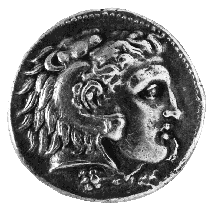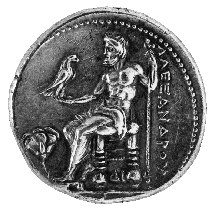



(41) Macedon, Alexander III - AR tetradrachm, 332-323 B.C.,
17.21 g. (inv. 91.053).
Obverse: Head of Herakles in lionskin cap r.
Reverse: Zeus enthroned l., holding eagle in r. and scepter
in l.; rose in l. field; DI-O beneath throne; ![]() : of Alexander.
: of Alexander.
Provenance: Bank Leu, 1971.
Bibliography: M.J. Price, The Coinage in the Name of
Alexander and Philip Arrhidaeus (Zurich and London 1991) 498 no. 397,
pl. CXIV.
Alexander the Great of Macedonia inherited his father's dream of conquering
the Persian empire. Soon after his father's assassination in 336 B.C., Alexander
led Greek and Macedonian forces into Asia Minor, sweeping down the coast
and liberating its Greek cities from the Persians. He occupied Syria and
Phoenicia and was accepted as pharaoh of Egypt. There he founded the important
city of Alexandria and visited the oracle of Zeus Ammon, where he was recognized
as a son of Zeus. He then turned eastward toward Mesopotamia, where he defeated
the main army of the Persians. Finally, he pushed further eastward, beyond
the Indus River, where in 327 B.C. his exhausted troops forced him to turn
back. On the return Alexander began to secure and organize his far-flung
empire, but in the summer of 323 B.C. he died of fever in Babylonia.
Alexander reformed Macedonian coinage, instituting types that would be circulated
throughout his empire long after his death. The most important were the
types on his tetradrachms, which soon replaced the Athenian "owls"
(see no. 30) as the most widely circulated coins
of antiquity. On the obverse is the head of Herakles, reference to his family's
claim of descent from the hero. Alexander was particularly devoted to Herakles
and in time came to be identified with him. Whether the features of Herakles
on the coins were subtly altered to those of Alexander in his lifetime is
uncertain, but after his death the image was widely regarded as a portrait
of Alexander. His father's use of the head of Zeus on his staters may have
inspired Alexander to put a full figure of Zeus on the reverse, but the
god acquired particular significance for him after the visit to the oracle.
Greeks recognized the figure as their chief god, but to the inhabitants
of Persian lands it could also represent their god Baal, also depicted enthroned
with an eagle and scepter.
The hundreds of small symbols and letters on the coins of Alexander and
his successors are probably control marks of particular issues, apparently
a system to safeguard the production of the coins. The marks on this coin
indicate that it was struck at Memphis during Alexander's lifetime.
K.L.R.



All contents copyright (c) 1996.
Lawrence University
All rights reserved.